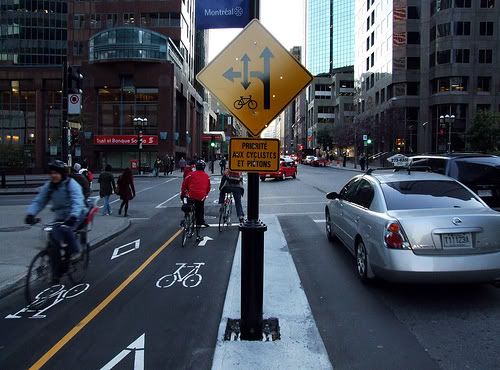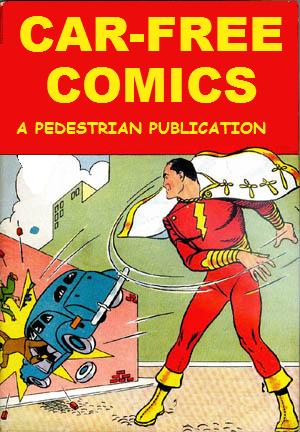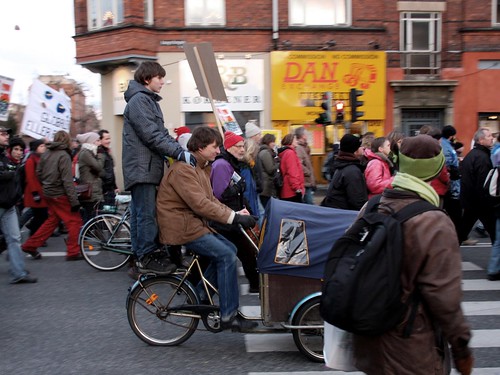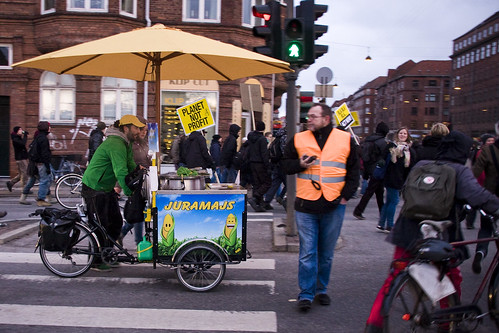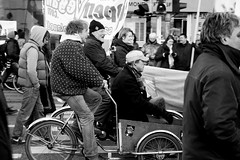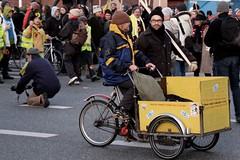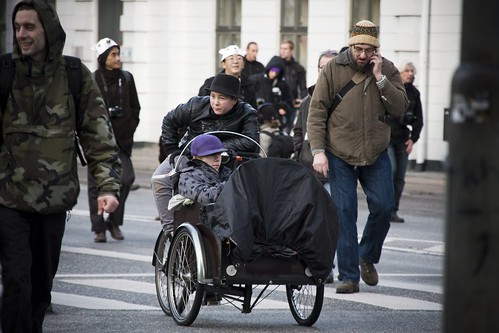A decent article on the issues from Montreal. I clipped out a section in the middle with some air pollution and injury stats.
Who owns the road in Montreal?
Montreal Gazette
MONTREAL – Jacob Larsen shivers in his thin windbreaker as he scans the downtown bike path from the safety of the sidewalk.
It's a nippy eight degrees and, aside from a bare-armed man in yellow and blue spandex, the cyclists whizzing by are dressed for the cold: one is swathed up to the eyes in a black muffler while another sports stylish, elbow-length fuchsia gloves.
But Larsen, a master's student in McGill University's School of Urban Planning, isn't interested in the riders' garb. He is watching intently for conflict between cyclists, drivers and pedestrians.
As if on cue, a silver sedan swerves left, narrowly missing a westbound cyclist.
It's just another heart-stopping moment on a cycle path where confrontations between different users of the road are the stuff of daily life.
With 560 kilometres of designated bike lanes built or under construction on the island, Montreal is ahead of the pack among North American cities when it comes to pedal power. (Those numbers include some lanes that are little more than a painted line, where bicycles share the road with other vehicles.) But spend some time on the downtown de Maisonneuve Blvd. cycle path and you'll see a backlash in full throttle.
Dotted by construction sites and intersections where cyclists, drivers and pedestrians compete, the bike path has fallen short of the utopian dream of a safe, cross-town bicycle boulevard. Frustrated drivers, reckless bikers and hapless pedestrians make for an explosive mix that is fuelling road rage and sparking debate over who owns the street.
"It's the whole problem of sharing the road," says Nathalie Valois, a Montreal police constable responsible for cycling safety.
"For some drivers, bicycles are just in the way," she says. "Then you get the cyclist who doesn't tolerate the drivers' behaviour." Larsen, lead researcher in a study on urban cycling by Transportation Research at McGill (TRAM), scribbles on a clipboard, jotting down details of the near-collision.
Urban planning professor Ahmed El-Geneidy is supervising the project, in which 20 student volunteers are observing conflict between bicycles, motor vehicles and pedestrians at 30 intersections..
The idea grew out of an online survey of 2,903 cyclists conducted by the cycle-research team over the summer. Respondents poured out tales of collisions and close calls while pedalling on city streets. They called for public-awareness campaigns to educate all road users - not only drivers, but also renegade cyclists who ignore traffic laws and mow down pedestrians.
"Sometimes drivers don't realize how vulnerable cyclists really are," says Larsen, as two bikers warily skirt a car nosing into the intersection. "For so many drivers, bicycles are just a hassle." Then there are the pedestrians who wander onto the bike path, oblivious to oncoming two-wheelers.
Half a block away from where Larsen stands, a pedestrian steps off the curb into the path of an oncoming cyclist, who jams on his brakes. The cyclist's response is inaudible but there's no mistaking the pedestrian's reply: a raised middle finger.
Manners aren't the only casualty in the war of the streets.
Last month, former Ontario attorney-general Michael Bryant was charged with criminal negligence causing death and dangerous driving after a 33-year-old cyclist was struck and killed in what witnesses allege was a grotesque road-rage episode.
While the death was an isolated incident, cyclists face an unacceptably high risk of injury, says Patrick Morency, a physician specializing in the health impacts of transportation at the city's public-health department, the Agence de la santé et des services sociaux de Montréal.
A 2003 U.S. study said cyclists' risk of being killed is 12 times that of car occupants, while pedestrians were 23 times more likely to be killed.
[clip]
“The more cars there are, the more people are injured,†he says. “The reality is that nearly all severe road injuries are caused by motor vehicles.â€
The backlash against cyclists is distracting attention from the real issue: the need to make transportation more sustainable, says Peter Furth, a professor specializing in transportation at Northeastern University in Boston.
“There’s a fundamental question: Is the bicycle welcome? Is it good for the health and happiness of our society?â€
Furth maintains that bike-friendly policies are an essential ingredient of sustainable communities. “If we’re going to have human-powered transportation in our cities, you’ve got to have cycling,†he says.
Copenhagen is a shining example of a bike-friendly city, says Larsen, who has family roots in Denmark and has cycled in the Danish capital.
“It’s a wonderful experience,†he says. “It’s leisurely and yet it’s speedy.â€
Copenhagen’s 1.9 million residents make 40 per cent of all trips by bicycle and the city aims to increase that proportion to half of all trips by 2015.
Cycling there cuts across all class and age barriers: parents with small children, fashionably attired office workers, the elderly.
“It’s the people you would never imagine on bicycles in Montreal,†says Larsen: “It’s not the eco-freak. It’s been integrated into the culture.â€
Street design is a key ingredient in Copenhagen’s safe bike culture, he says. The visual environment signals that cyclists and pedestrians, not cars, have priority.
Some of the city’s cycle paths are raised, like a sidewalk. They are a few inches lower than the sidewalk and a few inches higher than the roadway.
Other cycle paths are the same level as the road but separated by a barrier like the one along the de Maisonneuve path in Montreal.
Copenhagen also uses bright blue crosswalks to indicate that cyclists have right of way.
In Montreal, symbols painted in white on the asphalt indicate areas where cyclists share the roadway with vehicles. However, not everybody knows what the symbols mean and many drivers don’t notice them, Larsen points out.
The bicycle symbol accompanied by double arrows is known as a “sharrow†– a coinage derived from “share†and “arrow.†Larsen points to an example of sharrows on Union Ave. as an example of cycling symbols that are easy to ignore.
“In urban design, we talk about making the city legible,†Larsen says. Montreal has a long way to go when it comes to sending a clear message to drivers and cyclists, he says.
Along the de Maisonneuve bike path, overhead signs indicate that cyclists have the right of way at intersections. But many drivers overlook them – either because they don’t look that way or feel overloaded by all the other traffic signs to watch for, Larsen says.
Five years ago, Belgium inaugurated the Code de la rue, which gives priority to the most vulnerable travellers: pedestrians and cyclists. It includes urban-design changes and traffic rules such as giving cyclists the right to go the wrong way on one-way streets. Crosswalks across intersections are designed as an extension of the sidewalk, signalling that pedestrians and cyclists have priority. Other measures include a 30-kilometre-per-hour speed limit and physical barriers to slow car traffic.
But McGill’s El-Geneidy says measures to discourage car use must go hand-in-hand with public-transit alternatives.
“We have to accept that the car is dominant,†he says. “We can only change this when we have very good public transit.â€
Rather than investing in expensive measures like métro extensions, Montreal should first improve bus schedules and provide suburban train service at all hours instead of just during rush hour, he says.
Bike racks on buses would help integrate active transportation with public transit, he adds.
But Murtaza Haider, a management professor at Ryerson University and adjunct professor of engineering at McGill, says that for many Montreal-area residents, cars are a necessity. “I see cars as the means by which the middle class is able to have a meaningful life, he says.
“Apart from a two- to four-kilometre circle around downtown there is no cycling for work purposes,†he says.
Haider says he assigns students to buy a jumbo size bag of toilet paper and box of detergent and try to bring it home on their bicycles, to demonstrate that cycling is not suited to families.
But he believes that inner-city areas should deter car traffic, which harms residents’ quality of life.
“Through traffic shouldn’t be allowed. What people in Montreal have to do is mobilize. They should lobby the city to take traffic-calming measures,†he says. These could include speed bumps, flower pots to make intersections narrower, barring cars from turning left or right and one-way streets.
Back on the bike path, Larsen is looking forward to getting out of the cold after an hour of observation from his windy corner.
The tally: 327 cyclists pedalled past on the bike path. Larsen saw 15 conflicts between cyclists and drivers, two between cyclists and six between cyclists and pedestrians.
“I think this is a timely study because Montreal is on the verge of becoming a real bicycle city,†he says.
The more people cycle, the more drivers get used to them, and the safer cycling becomes, Larsen says. You can see that in the Plateau Mont Royal, he says, where cycling accounted for 6.5 per cent of trips in 2006.
“When you bike around the Plateau, drivers are not as hostile. Drivers expect thereo be bicycles.â€
But until there is a broader social consensus around cycling, accidents will happen, he says. “There’s an improvement in safety, but you could be unlucky.â€





